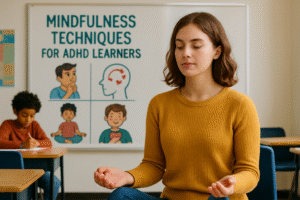
Overcoming distraction in online learning
Online learning opens up a world of opportunities, but it also carries a unique set of challenges—especially for those with ADHD. The digital landscape is full of notifications, multitasking temptations, and the subtle lure of infinite scrolling. For neurodivergent learners, distractions do not simply reduce efficiency; they directly impact self-esteem, learning outcomes, and the very experience of education itself.
Understanding Distraction in Digital Spaces
In the context of online education, distractions are not just external interruptions like phone calls or emails. They are also the result of cognitive overload, decision fatigue, and the constant switching between tasks that digital environments frequently demand. For ADHD learners, these factors are not minor inconveniences—they are significant barriers to focus and retention.
“Distraction is not a lack of discipline; it is often a mismatch between the demands of the environment and the way our brains process information.”
While everyone is susceptible to digital distraction, research shows that people with ADHD experience increased executive function challenges. These include difficulties with organization, prioritization, and regulating attention. Traditional advice like “just turn off notifications” or “find a quiet place” seldom addresses these deeper neurological needs.
The Unique Needs of ADHD Learners
ADHD is often misunderstood as simple inattentiveness. In reality, it involves a complex interplay of attention regulation, hyperfocus, and distractibility. Online learning environments can exacerbate these issues with their reliance on self-motivation, time management, and sustained attention.
For many neurodivergent learners, the pressure to meet standardized expectations—such as following rigid schedules or consuming large amounts of information quickly—can be overwhelming. The result? Increased anxiety, decreased self-confidence, and, sadly, a sense of alienation from the learning process itself.
Practical Strategies for Limiting Distraction
Empowering ADHD learners in online education means going beyond generic productivity tips. It requires a blend of technological tools, environmental design, and compassionate self-awareness.
1. Designing a Personalized Digital Workspace
One of the most effective ways to reduce distraction is to create a digital environment tailored to individual needs. This often means:
- Using browser extensions that block distracting websites during study sessions
- Organizing bookmarks and desktop files to minimize visual clutter
- Customizing notification settings to only allow essential alerts
For example, tools like Freedom or Cold Turkey can temporarily block access to social media or entertainment sites. Meanwhile, apps like Notion or Trello help with task organization—essential for ADHD brains that thrive on visual cues and structure.
2. Leveraging the Power of Microlearning
Long, uninterrupted lectures rarely benefit those with ADHD. Instead, breaking content into smaller, manageable modules—microlearning—can make a world of difference. This approach not only fits the natural attention span of many neurodivergent learners but also allows for frequent breaks and review sessions.
Microlearning platforms or video segments under ten minutes can be strategically integrated into study routines. This not only reduces cognitive overload but also provides regular moments of achievement—boosting motivation and confidence.
3. Building a Routine with Flexibility
While structure is crucial, rigid schedules can backfire for ADHD learners. Flexible routines that allow for short, spontaneous breaks, physical movement, or even a change of scenery can help maintain focus without causing frustration.
“Routine is not about control. It’s about creating a rhythm that supports your brain’s natural patterns.”
Setting timers, using visual planners, or even simple checklists can help mark progress and reduce the anxiety that comes from open-ended tasks.
4. Incorporating Movement and Mindfulness
ADHD brains often crave stimulation and novelty. Sitting still for prolonged periods can degrade attention and retention. Incorporating short physical exercises, stretching, or even standing workstations can re-energize focus.
Mindfulness exercises—such as deep breathing or guided meditation—are not about emptying the mind, but about gently redirecting attention. Just five minutes of mindful breathing before a study session can make a noticeable difference.
The Role of Technology: Friend or Foe?
Ironically, the same technology that can distract us is also a powerful ally in supporting ADHD learners. The key is intentional use—choosing tools that reduce friction and empower self-regulation.
Assistive Technology for Attention Management
- Text-to-speech tools enable auditory learning, giving the brain multiple channels to process information.
- Task management apps like Todoist or Things provide visual reminders and help break complex projects into actionable steps.
- Focus timers, such as the Pomodoro Technique, use intervals of work and rest to maintain engagement without burnout.
These tools are not just productivity hacks—they are accessibility resources, making online learning more inclusive and equitable.
Reducing Multitasking Temptation
Multitasking is a myth, especially for ADHD learners. Switching between tabs, messaging apps, and videos can drain cognitive resources quickly. Establishing a “single-task zone”—a dedicated browser window or workspace for each task—can limit the temptation to multitask.
Some learners benefit from using separate devices for different purposes: one device for coursework, another for communication or entertainment. This physical separation reinforces boundaries and reduces accidental distractions.
Self-Compassion and Community Support
Managing distraction is not just about willpower or the right set of tools. Self-compassion—the ability to forgive lapses and celebrate small victories—is essential for sustainable progress.
“Progress in online learning is rarely linear. Every learner, especially those with ADHD, deserves patience—both from themselves and from their educators.”
Community support is equally important. Online study groups, peer accountability partners, and mentorship programs can provide encouragement and practical advice. Sharing experiences with others who face similar challenges reduces isolation and fosters resilience.
Educator’s Role in Reducing Distraction
For instructors and educational designers, creating ADHD-friendly online courses means:
- Offering materials in multiple formats (videos, transcripts, slides)
- Breaking assignments into smaller steps with clear deadlines
- Providing regular feedback and check-ins
- Encouraging questions and collaboration, rather than penalizing mistakes
When courses are designed with neurodiversity in mind, everyone benefits—not just ADHD learners. The principles of Universal Design for Learning (UDL) ensure flexibility, choice, and accessibility for all.
Embracing Neurodiversity in Tech Education
The technology industry thrives on innovation and fresh perspectives. Neurodivergent minds bring unique strengths to the table—creativity, curiosity, and the ability to see connections others might miss. By supporting ADHD learners in online education, we are not just making learning more accessible; we are nurturing the next generation of tech visionaries.
It is crucial to remember that attention is not a finite resource to be rationed, but a relationship to be cultivated. With the right environment, tools, and community, every learner can find their rhythm—even in the noisiest digital world.
Let’s continue to build educational spaces that honor difference, embrace flexibility, and empower all minds—neurodivergent and neurotypical alike—to thrive in technology and beyond.


